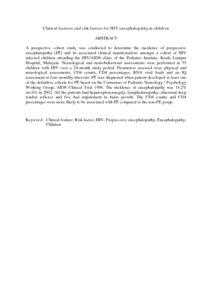Citation
Abd Hamid, Mohd Zaini and Aziz, Noor Azah and Syed Zakaria, Syed Zulkifli and Othman, Norlijah and Mohd Razali, Kamarul Azhar
(2008)
Clinical features and risk factors for HIV encephalopathy in children.
The Southeast Asian Journal of Tropical Medicine and Public Health, 39 (2).
pp. 266-272.
ISSN 0125-1562
Abstract
A prospective cohort study was conducted to determine the incidence of progressive encephalopathy (PE) and its associated clinical manifestations amongst a cohort of HIV
infected children attending the HIV/AIDS clinic of the Pediatric Institute, Kuala Lumpur Hospital, Malaysia. Neurological and neurobehavioral assessments were performed in 55 children with HIV over a 24-month study period. Parameters assessed were physical and neurological
assessments, CD4 counts, CD4 percentages, RNA viral loads and an IQ assessment at four monthly intervals. PE was diagnosed when patient developed at least one of the definitive criteria for PE based on the Consensus of Pediatric Neurology / Psychology Working Group, AIDS Clinical Trial 1996. The incidence of encephalopathy was 18.2% (n=10) in 2002. All the patients had hepatosplenomegaly, lymphadenopathy, abnormal deep tendon reflexes and five had impairment in brain growth. The CD4 counts and CD4 percentages were more likely to be associated with PE compared to the non-PE group.
Download File
![[img]](http://psasir.upm.edu.my/13607/1.hassmallThumbnailVersion/Clinical%20features%20and%20risk%20factors%20for%20HIV%20encephalopathy%20in%20children.pdf)  Preview |
|
PDF (Abstract)
Clinical features and risk factors for HIV encephalopathy in children.pdf
Download (85kB)
| Preview
|
|
Additional Metadata
Actions (login required)
 |
View Item |

